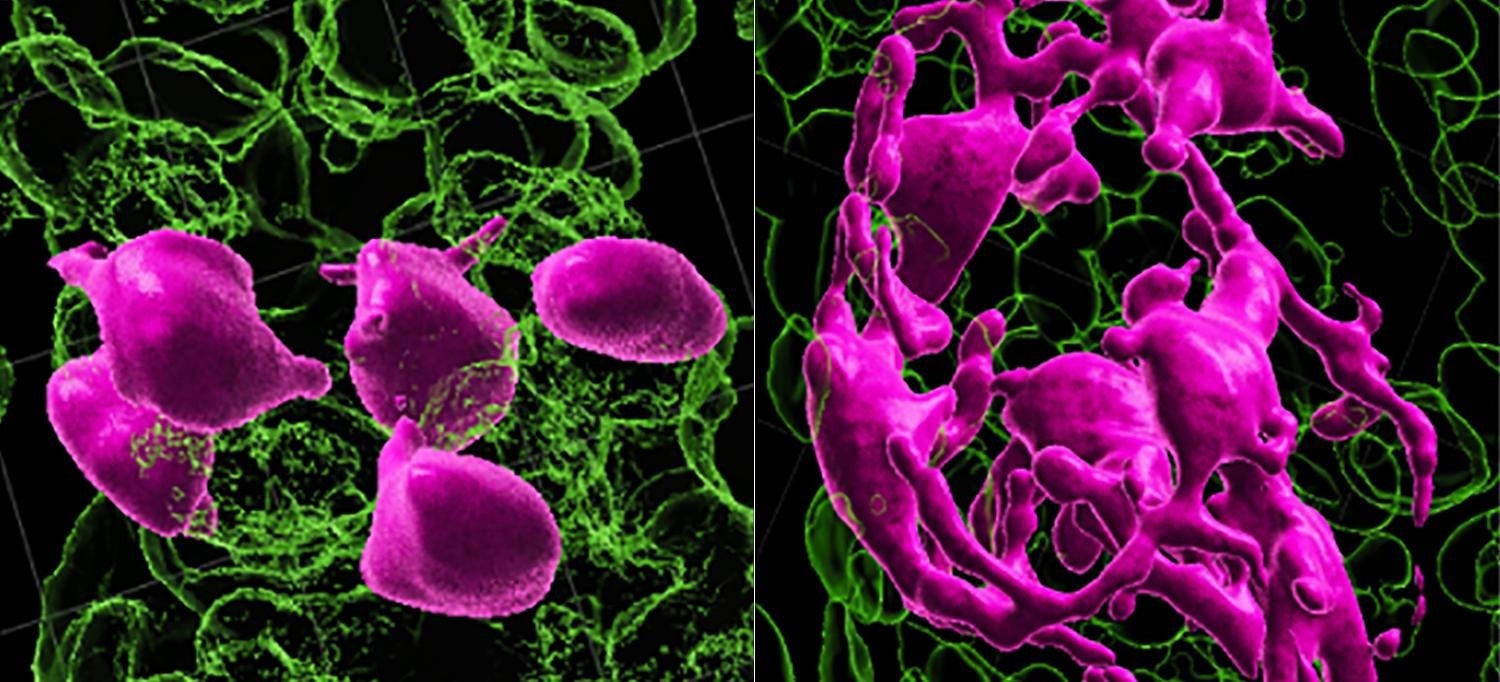Some stem cells have a special capacity to mobilize among growth compartments in hair follicles; however, they get stuck with age in people. Hence, they lose their capacity to mature and retain hair color, as per new research.

Hair-coloring stem cells (at left, in pink) need to be in the hair germ compartment in order to be activated (at right) to develop into pigment. Image Credit: Springer-Nature Publishing
Guided by scientists from NYU Grossman School of Medicine, the new work concentrates on mice skin cells and also discovered in humans known as melanocyte stem cells, or McSCs. Hair color is managed by whether nonfunctional but continually reproducing pools of McSCs within hair follicles get the signal to turn into mature cells that create the protein pigments accountable for color.
The new research revealed that McSCs are remarkably plastic. This study was published online in the journal Nature, on April 19th, 2023. This implies that at the time of normal hair growth, those cells continually move front and back on the maturity axis as they transfer between compartments of the growing hair follicle. It is within these compartments where McSCs are exposed to various levels of maturity-prompting protein signals.
Particularly, the study group discovered that McSCs alter between their most primitive stem cell state and their next maturation stage, the transit-amplifying state, and based on their location.
The scientists discovered that as hair ages, falls, and then again grows back, more numbers of McSCs get stuck in the stem cell compartment known as the hair follicle bulge. They stay there, do not grow into the transit-amplifying state, and do not move back to their original position in the germ compartment, where WNT proteins would have urged them to regrow into pigment cells.
Our study adds to our basic understanding of how melanocyte stem cells work to color hair. The newfound mechanisms raise the possibility that the same fixed positioning of melanocyte stem cells may exist in humans. If so, it presents a potential pathway for reversing or preventing the graying of human hair by helping jammed cells to move again between developing hair follicle compartments.”
Qi Sun, PhD, Study Lead Investigator and Postdoctoral Fellow, New York University Langone Health
Scientists state that McSC plasticity does not exist in other self-regenerating stem cells, like those building the hair follicle itself, which are known to travel in only one direction along a proven timeline as they grow. For instance, transit-amplifying hair follicle cells never return back to their actual stem cell state. This describes partially why hair can continuously grow even when its pigmentation fails, states Dr Sun.
Past studies by the same study group at NYU Grossman School of Medicine revealed that WNT signaling was required to trigger the McSCs to mature and generate pigment. That research also exhibited the fact that McSCs were many trillions of times less exposed to WNT signaling in the hair follicle bulge when compared to the hair germ compartment, which is located directly below the bulge.
In the recent experiments in mice whose hair was aged physically by plucking and forced regrowth, the number of hair follicles with McSCs lodged in the follicle bulge amplified from 15% before plucking to almost half following forced aging. Such cells stayed inefficient in regenerating or growing into pigment-producing melanocytes.
The stuck McSCs, found by scientists, stopped their regenerative behavior as they were not exposed to much WNT signaling anymore and thus their capacity to generate pigment in new hair follicles, which kept growing.
Unlike this, other McSCs that kept moving front and back between the follicle bulge and hair germ retained their capacity to regenerate as McSCs, grow into melanocytes, and generate pigment over the complete two-year study period.
It is the loss of chameleon-like function in melanocyte stem cells that may be responsible for graying and loss of hair color. These findings suggest that melanocyte stem cell mobility and reversible differentiation are key to keeping hair healthy and colored.”
Mayumi Ito, PhD, Study Senior Investigator and Professor, Ronald O. Perelman Department of Dermatology and Department of Cell Biology, New York University Langone Health
Dr. Ito stated the team plans to examine the methods of restoring motility of McSCs or of physically pushing them back to their germ compartment, where they can create pigment.
For the research, scientists employed the latest 3D-intravital-imaging and scRNA-seq methods to monitor cells in nearly real-time as they grew old and traveled within each hair follicle.
Source:
Journal reference:
Sun. Q. et al. (2023) Dedifferentiation maintains melanocyte stem cells in a dynamic niche. Nature. doi.org/10.1038/s41586-023-05960-6.